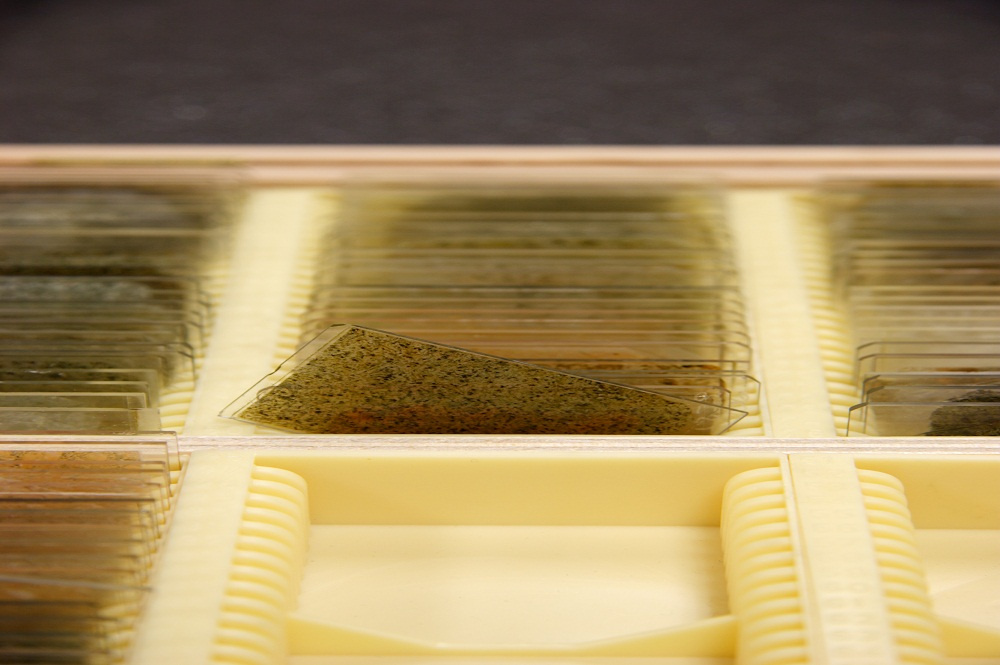Explaining the Thin Section Preparation: The Key Process Involved
If you're getting started with the study of palynology, you're going to need thin sections to perform your research. Learn about what they are, how to make them, and the materials required.
Thin Section Primer
 A thin section is usually a rock, but may also be a soil, pottery, bone, or metal sample used in mineralogy and petrography. The material is cut with a diamond saw to turn it into an incredibly fine object mounted on a glass slide to study its optical properties.
A thin section is usually a rock, but may also be a soil, pottery, bone, or metal sample used in mineralogy and petrography. The material is cut with a diamond saw to turn it into an incredibly fine object mounted on a glass slide to study its optical properties.
Researchers place it between two polarizing light filters to figure out its origin and evolution history. They may also take photographs of the sample for further study.
Materials and Equipment
To make thin sections properly, you have to be prepared. Here are the materials and equipment you're going to need:
· Sample Material
· Glass Slide
· Vacuum Chuck
· Slab Saw
· Grinder
· Cut-Off Saw
· Lap Wheels
· Permanent Marker
Procedure
The procedure may seem complicated if you're just a beginner, but you shouldn't encounter any problems as long as you follow it step-by-step. Here's what you need to do:
1. Frost the Slide
Before you start cutting, have everything in order, beginning with the glass slide. It has to be frosted to ensure that the surface is flat and has a uniform thickness. It'll also remove any spots, which can interfere with your research.
All you have to do is to place a clean slide on your vacuum chuck. Then, start grinding it against your diamond wheel, moving it back and forth until it's completely marked and has a milky white color. Once that's finished, wash it and see if it's evenly frosted. If it isn't, repeat the process until you're satisfied.
2. Mark the Rock
Now, it's time to prepare your sample. First, decide where you're going to cut. This isn't something to be taken lightly.
Generally, you should take a section perpendicular to the rock's fabric to avoid damaging the material. Once you've chosen the part you want to sample, draw a line on it using a permanent marker.
3. Start Cutting
Typically, you'll be dealing with a large piece of rock. Before refining it into something that'll fit on a glass slide, cut it down into a more manageable size. Place it in the slab saw so that the line you've made is parallel to the blade. Make sure you close the cover before you start! Turn the machine on. The stone will fall onto a catch tray once it's finished.
4. Refine the Sample Further
After you've cut everything, wash the slabs to remove any oil and grit from the saw. It's also best to mark each piece with a number to prevent mix-ups.
Now, you have to reduce the slab to a thin, useable sample. Use your trim saw with a diamond blade. Cut it until it's slightly smaller than the glass slide. Don't forget to wear protective gear during the process to prevent accidents.
5. Glue to the Slide
 Write the sample number on the frosted side of the glass and heat the stone on a hot plate. Keep the polished side up to stop it from getting dirty. You're also going to need a batch of glue that's two parts epoxy and one part hardener.
Write the sample number on the frosted side of the glass and heat the stone on a hot plate. Keep the polished side up to stop it from getting dirty. You're also going to need a batch of glue that's two parts epoxy and one part hardener.
Put a few drops of glue on the polished side of the chip. Wait for 5 minutes to let the rock soak it in before spreading more epoxy. Repeat the process until the sample can't absorb any more.
Place the glass on it, frosted side down. Move it around your fingers to remove extra glue and air bubbles. Let it cure for 20-30 minutes.
6. Grind to the Correct Thickness
Now, you have a piece of stone glued to a glass slide. But, it's not quite ready. You still have to cut most of it off, leaving only a thin slice attached.
Once you've done that, you need to grind it down even further. Do it slowly and carefully, since it's a delicate part of the process. Move the sample across the grinder. Periodically check on it under an electronic microscope. Once you can identify the minerals, then you've reached the appropriate thickness.
Making thin sections is a big part of  palynology. Contact National Petrographic to buy the materials and equipment you need so you can get started.
palynology. Contact National Petrographic to buy the materials and equipment you need so you can get started.






